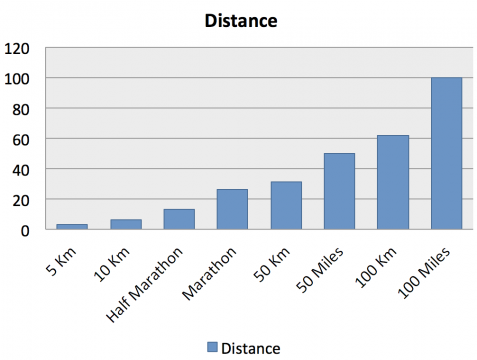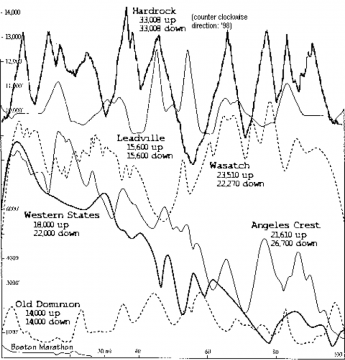By HPRS Race Director “Sherpa” John Lacroix
Previously I wrote a post titled “Choosing Your First Ultra.” For those of you seriously considering bringing your ultra running to the next level, and into the world of 100 milers, I of course suggest you click the link above and read that post. Much of the advice I gave then, still applies here when choosing which 100 Miler to be your first. As a review, the discussion points discussed in that post were:
• Shoot for the moon, Land Amongst The Stars
• Each Course Has Variables
• Ask Questions of Fellow Ultra-Runners
• Decide What’s Worth The Price
• Old School vs. New School
• Roads, Trails, or Wilderness
• Nix The First Year Event
• Decide on a Distance
There really is some fruitful conversation within those topics and again, I urge you to delve deeper. However, now that we know what distance we want to run (100 Miles), I want to really focus in on the following very important discussion points on deciding which 100 Miler to make your first.

1.) Rely On Your Progressive Experiences
Let me start by saying that I am strongly against folks relying on their marathon training in order to run a 100-miler. I’m also against folks jumping from 26.2 right to 100 miles. Though it’s been done before, studies will show “varied results.” I may go over training for a 100 in a future post, but for now I’d like to impress upon you the notion of running a marathon, then a 50K (31.05), then a 50 miler (and perhaps a 100k); on your way to your first 100. I would take a look at the ultra’s you’ve completed on your journey to your first 100, and try to match your selection for a first 100 based on your collective previous experiences. If you’ve run a rugged, mountain 50 miler and didn’t have much fun; then stay away from those types of 100s when selecting a first 100. If you bore easily and can’t stand pavement for 24+ hours; then stay away from multiple-loop courses and courses which feature loads of paved running.
2.) Just Because You Read It In A Book…
Two of the most popular ultra running books of all time, UltraMarathon Man: Confessions of an All Night Runner and Born To Run, are loosely based on running the Western States 100 Mile Endurance Run, Leadville Trail 100, and the Badwater 135. Just because you read about these races in a book, doesn’t necessarily make them good ideas for first time 100 milers, and there’s also some hyperbole nestled within those pages which could set you up for different expectations. When I started running 100 Milers (2007), there were around 35 in the United States. Now, there’s over 150. There are plenty of 100’s to choose from and many of them make for a good time. To see a list of the 160+ North American 100 Milers, Check out Stan Jansen’s Site at http://www.run100s.com. It’s likely you have an incredible 100 right in your own back yard. There is nothing worse than training for a race that is a few thousand miles from home, then showing up and laying an egg with your family in closest friends as your audience. What’s the rush? If you really want to experience what you read about in a book.. I say go for it.. but if you plan to be running 100s for a long time to come, what’s the rush? You’ll get there…

3.) What Is A Good First 100-Miler?
This question has been asked many times before and the answers always seem to be the same: Vermont, Umstead, Rocky Raccoon, Burning River, Oil Creek. All great suggestions… but why? Many ultra-veterans consider these races to be some of the “easier” 100-milers, and forgive me as there are others I have failed to submit that are also exceptional 1st time 100s. Now certainly there is no such thing as an easy 100; but as far as 100 milers go, these tend to be the most runner friendly. Generous cut-offs, challenging courses yet not a “graduate run” type experience, ample aid stations, numerous chances of having access to your crew/supporters. It doesn’t really get much better than that. Other suggestions might be races that feature multiple loops of 10 miles or less at a time (if you’re into that kind of thing). Courses like this allow you to access your crew and/or your drop bags at a frequent and always guaranteed clip. In other words, you can count on seeing your aid and people every 10 miles. Keep in mind though, that those multiple loop courses tend to be the easiest to quit on. Nothing lures a runner away when their hurting like the sight of their tent or a warm car. Set yourself up for success, and not the easy way out.
4.) Consider the Terrain
I can’t stress this enough. I’ve been to many races and have seen the following countless times. Example: One year while running the Massanutten Mountain Trails 100 in Virgina, I struck up a conversation with another participant. This runner informed me that, “So far the course is killing me.” Why? Because Massanutten is one of the rockiest, nastiest, 100s East of the Mississippi. It offers up 18,000+ feet of elevation gain (and loss) over the course of 100 miles with every rock known to man laid out upon the course. The runner, who was running it as their first 100, flew in from the farm fields of Kansas. They have no mountains, and no rocks, where he trained and thus, the challenge was more than he bargained for and the experience.. not as amazing as he had always envisioned. For those other races, consider that Western States is a 90% downhill run on technical trail and fire roads. Leadville is mostly a road run with incredibly tight cut-offs, forcing runners to run at every chance they get. Not to mention that it happens at 10,000′! Food for thought. Look at the areas you think you’ll be able to train on. Now choose a 100 mile course the most closely resembles what you have available to you. You’ll be thankful for it in the end. Save the Big Hairy Audacious Goal 100 after you have one or two under your belt.
5.) Research, Research, Research
I’m talking about the race itself. For instance, take the Vermont 100. A quick Google Search for “Vermont 100 Mile Endurance Run” offers up countless bits of information. From the race website (read it in it’s entirety!), to videos, to race reports, to news and magazine articles. There is a mountain of information out there on the web that speaks about the event. After a look at the information available on the web, I should be able to decide if I want to run this race or not. But what exactly am I looking for with my initial research of events?
The Following: Course length, elevation gain/loss, Elevation profile, course description, photos of what the course actually looks like, historical weather information for the area that time of year, number of years the event has been put on, who does the race benefit if anyone, how much does it cost, number of aid stations and the average distance between them, number of times my crew can access me and the average distance between those times as well, number of finishers the last 3 years, average number of finishers to starters on any given year (testament to difficulty of the event), and finally.. the course records.
6.) Then Research Some More!
After you’ve done the initial research outlined above; watch some videos that other runners have made about their time at the event. Given the success of YouTube, you’re bound to find plenty of videos to peruse. A search on the VT100 lands quite a few YouTube videos on the first page! Read a few race reports of runners who have been there. Most times they’ll be incredibly honest with their thoughts on the event as a whole regardless of their success or not. This beta will help you decide if it’s an event you truly want to run or not. You’ll either get fired up, goose bumps, and tingly inside after watching videos or reading reports; or you are none-of-the-above. If you are none-of-the-above, move on to researching another event. If you’re fired up and can truly envision yourself running across the finish line, you’ve found your race!
7.) Consider The Distance and Accumulated Time
After doing all of the research above, ask yourself these questions, “Does it sound like an event I’d enjoy being on my feet for 30 hours at? Does it sound like an event that I can see myself being on my feet, running, for 24+ hours? Does it sound like something I could get people to help me out with? Does it sound like an event that I could be proud to say I was apart of?” Only with these answers can one truly discover if a particular race is for them. Don’t put all your eggs in one basket. If you want to run a 100-miler just once and then move on forever.. then forget everything I’ve just said and go for it! Have at it! But if you want to truly run a 100 miler, enjoy yourself, have the time of your life, push yourself, and consider doing it again someday down the road.. then pay close attention to the advice I’ve given here.
In my 11 years of running 100-milers, I’ve been to some really great events and some that were OK or so-so. I’ve met some amazing race directors, and some who I felt were perhaps in a bit over their head. At the end of it all.. running 100 milers is ultimately up to you. If you have questions about a particular race, send me an email and I’d be happy to help you sort through your decision making process. Many people will discount themselves by proclaiming their lack of preparedness to take on such a challenge. Running 100-miles is 90% Mental. Your legs know what to do, your brain is what needs the training. What I’ve outlined above is a look into the mental aspects associated with selecting a great first 100. The choice is ultimately yours, and I truly want you to have an awesome time pursuing your goals. Just be smart!
HPRS hosts the Silverheels 100 on July 7-8 in Fairplay, CO. We’ve had many folks join us at SH100 for their first 100. For me, there is no higher honor in life than to award someone their first 100 buckle. If Silverheels sounds too challenging or unlike something you’d enjoy but you still want to accomplish the feat with HPRS, look into the 2019 Stories Ultra or the 2019 Sangre de Cristo Ultras as future options. We’d love to have you.
Challenge yourself. Discover your Human Potential.
